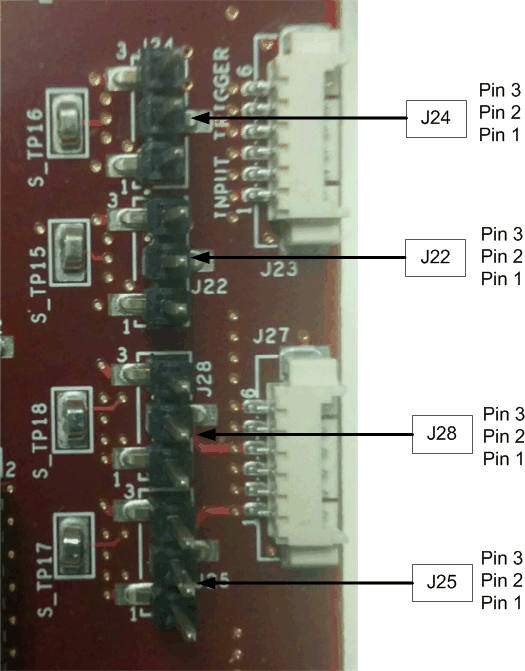DLPU102B December 2020 – July 2022
- Read This First
- 1DLP LightCrafter Dual DLPC900 EVM Overview
- 2Quick Start
-
3Operating the DLP LightCrafter Dual DLPC900 EVM
- 3.1 DLP LightCrafter Dual DLPC900 Control Software
- 3.2 PC Software
- 3.3 System Common Controls
- 3.4 System Settings
- 3.5 Video Mode
- 3.6
Pattern Modes
- 3.6.1 Menu Bar
- 3.6.2 Creating a Pattern Sequence in Pattern On-The-Fly Mode
- 3.6.3 Creating a Pattern Sequence in Pre-Stored Pattern Mode
- 3.6.4 Reordering a Pattern Sequence using the Edit LUT Feature
- 3.6.5 Creating a Pattern Sequence in Video Pattern Mode
- 3.6.6 Creating a Pattern Sequence With DMD Block Load
- 3.6.7 Pattern Settings
- 3.7 Batch Files
- 3.8 Peripherals
- 3.9 Firmware
- 3.10 Flash Device Parameters
- 3.11 JTAG Flash Programming
- 3.12 Intel (Altera) FPGA Programming
- 4Connectors
- 5Power Supply Requirements
- 6Safety
- 7Revision History
1.5.2 DLP LightCrafter Dual DLPC900 Trigger Input and Output Voltage Selectors
The trigger inputs on J23 are inputs from external devices to control the pattern sequence. While trigger input 2 is high, trigger input 1 advances the pattern sequence to the next pattern in the sequence on every pulse.
The trigger outputs on J27 are outputs to control external devices. While trigger output 1 frames the exposure time of the pattern, trigger output 2 pulses to mark the beginning of each pattern.
Both input and output triggers have voltage level selectors. Use J22, J24, J25, and J28 to select the voltage as shown in Figure 2-4. If no voltage is selected, then the onboard logic is not functional and any outgoing or incoming signals are not available.
 Figure 1-4 DLP LightCrafter Dual DLPC900 EVM Trigger Voltage Level Selectors
Figure 1-4 DLP LightCrafter Dual DLPC900 EVM Trigger Voltage Level Selectors